We have a strict honesty policy, but please note that when you buy through our links, we may earn a commission. Learn more.
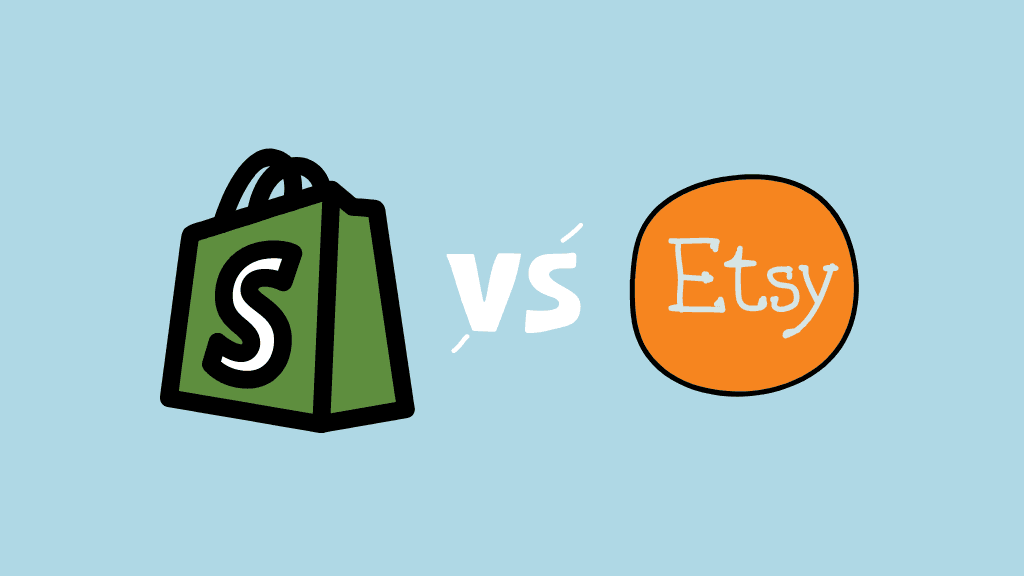
In this Shopify vs Etsy shootout I compare two of the most popular solutions available for selling products online. Which platform is right for you? Or can you use both?
Let’s find out…
The key differences between Shopify and Etsy
Shopify and Etsy are two big names in the ecommerce world — and both platforms let you put your products before a large online audience. But they are very different tools.
There are two key differences between Shopify and Etsy you need to be aware of:
- How you sell goods.
- What you can sell.
Let’s dig into these.
HOW you sell goods on Shopify and Etsy
Shopify is a popular website building platform that lets you build your own online store. Over 5.5 million stores are powered by it.
Etsy, by contrast, is an existing online store (and a big, well-known one at that, with recent statistics indicating that around 8 million merchants use it to sell to around 96 million customers).
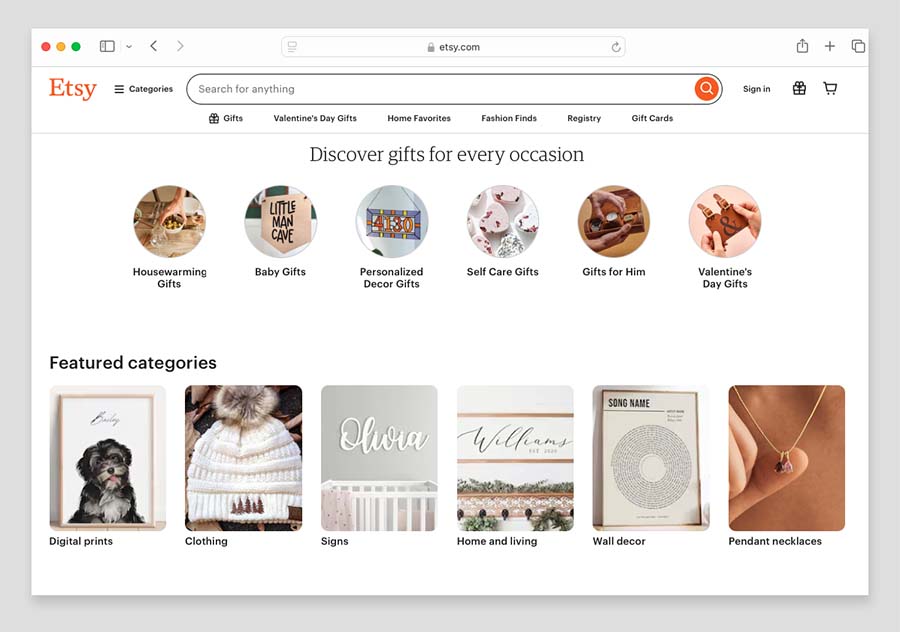
When you sell on Shopify, it’s like renting a space where you set up your own shop — but selling on Etsy is more like selling your goods in a supermarket.
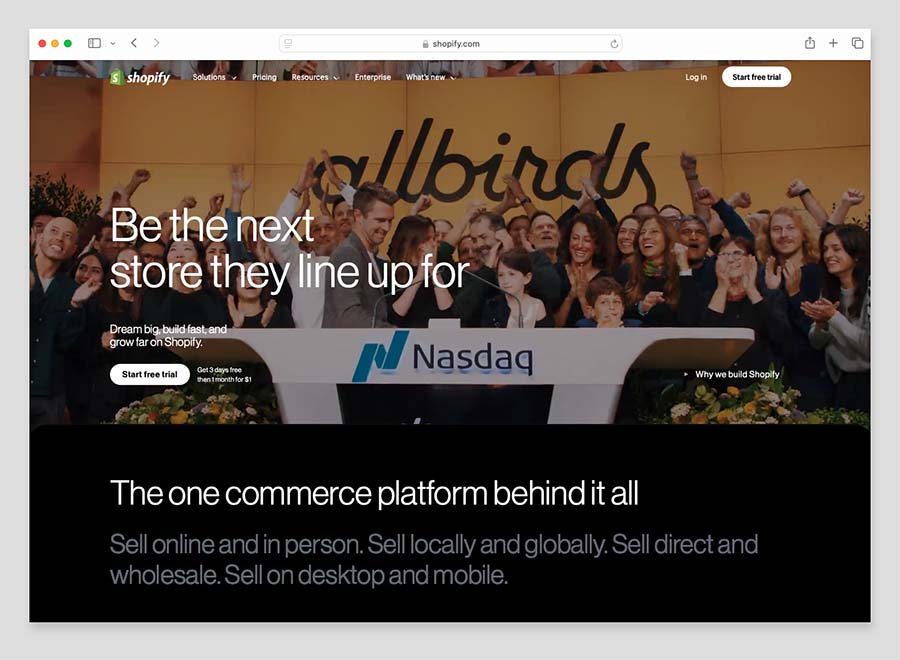
With Shopify, you’ll have a lot more work to do to configure things the way you want — and find customers. However, you’ll also have a lot more say over everything. For example, you can control:
- the domain name for your store
- how your brand is presented
- what your store looks like
- the way you sell your goods.
With Etsy, the customers are already there — but so is your competition. To continue the supermarket analogy, hosting a store on Etsy is like having some shelf space in an aisle. Lots of customers will walk past it, but will they reach out for one of your products — or grab one of your competitors’?
Both these ways of selling online have their pros and cons — I discuss these in more depth later on in this comparison. But first, a look at the other main difference between the two solutions — what you can actually sell.
WHAT you can sell on Shopify and Etsy
Shopify lets you sell pretty much anything — so long as it’s legal to do so in the country you’re based in.
By contrast, Etsy only lets you sell certain types of products — items that are:
- Made by a seller — handcrafted items that are physically made by you (or using tools operated by you)
- Designed by a seller — digital designs made by you
- Handpicked by a seller — vintage items, items from nature, etc.
- Sourced by a seller — craft supplies, party decorations and items personalized with a buyers’ unique text or image.

In practice, this generally restricts you to selling your own handmade goods, vintage items, craft supplies and digital products.
So, if you’re not going to be selling these type of products, then Shopify — or another ecommerce platform — is the more obvious choice.
If you are selling these types of products, then either platform will work fine — with Etsy bringing the added advantage of an existing audience that particularly likes handmade and crafty items.
(Note: Etsy does let you sell other types of goods if you use its ‘Pattern’ product — more on that in a moment).
Now that we’ve looked at the basics of how Shopify and Etsy work, let’s move onto how easy they are to use.
Ease-of-use
Etsy and Shopify are both designed to be easy for ecommerce novices to start selling with.
When you sign up for an account on either platform, an onboarding process is provided that takes you through the key steps needed to start selling. Additionally, a range of online resources and video tutorials is available to further support you.
(Shopify’s are more extensive however — and some of the Etsy ‘how to’ videos are a bit old).
The learning curves for both platforms, whilst not terribly steep, are different, though.
With Etsy, you are basically adding listings to an existing online marketplace. This isn’t quite as easy as it sounds — you’ll need to give a fair bit of thought to copy, imagery and pricing of products. But it’s a relatively straightforward process (as the video below demonstrates).
With Shopify however, you are building an entirely new website. So, in order to get your Shopify store off the ground, you will need to familiarize yourself with tasks like:
- creating your own brand
- customizing templates
- building web pages
- mapping domains.
(And all that’s before you get to adding products!).

Although Shopify has been designed to facilitate this in as easy a way as possible, if you’re new to web design, there is still a fair bit to learn.
Tip: our quickstart guide on how to start a Shopify store helps to make the process of building a Shopify store faster and easier, as does our Shopify tutorial for beginners on YouTube.
Managing Shopify and Etsy stores on the go
In addition to their standard web interfaces, Shopify and Etsy can both be used via mobile apps, ‘Shopify’ and ‘Sell on Etsy’ (which are both available for both iOS and Android). These apps let you create or update product listings and manage orders.
The Shopify app scores 4.7 out of 5 on the iOS app store and 4.3 on the Google Play store. The Etsy app scores 4.6 stars out of 5 in both the Apple App Store and Google Play Store.
Control over branding and user experience
When you sell on Etsy, there are limits to how you can present your business online. You can add a logo and a banner to your storefront — but that’s more or less it.
So in general, your online presence is going to look very ‘Etsy-like,’ and you won’t be able to create much of a bespoke shopping experience using the platform.
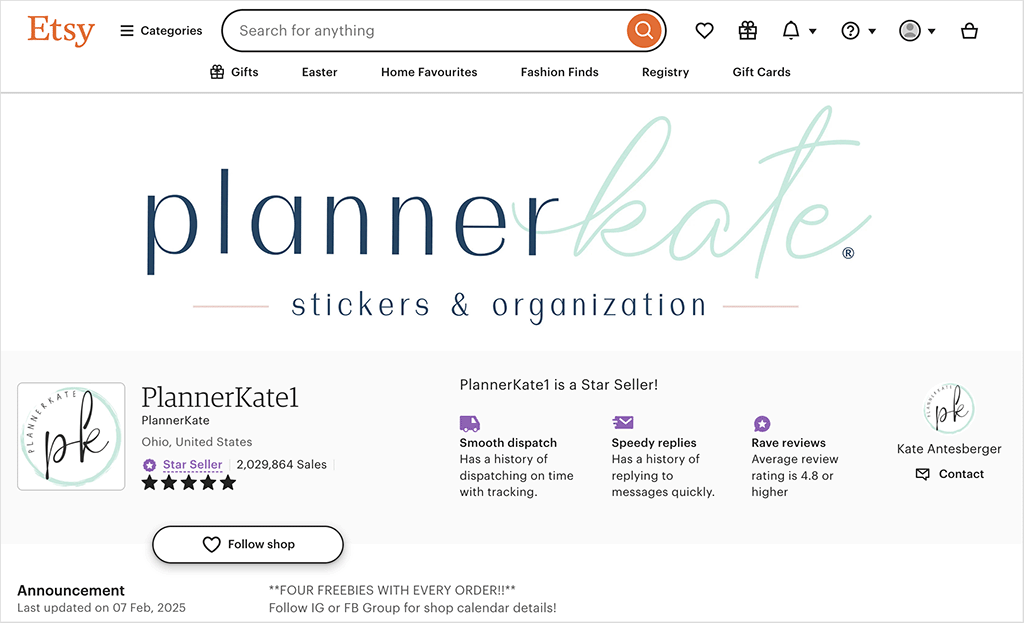
Now, because Etsy users expect a certain type of look and feel, this is probably a good thing — moving too far away from the Etsy shopping experience might actually have a negative effect on sales.
Shopify works very differently when it comes to customization: it gives you a huge amount of control over your brand and user experience.
A wide range of templates for Shopify is available (246 in total); and these can be extensively tweaked to match your branding requirements (and via CSS and HTML too, if you have the relevant technical skills).
You can browse all the available Shopify templates here.
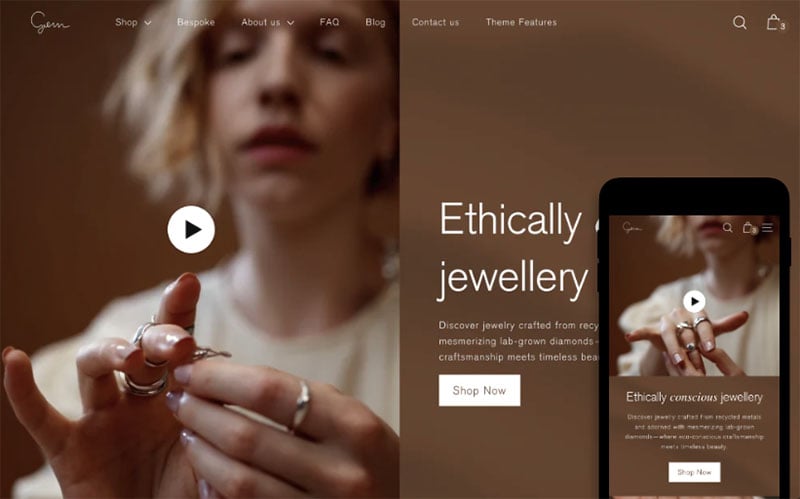
Sophisticated multi-currency and multilingual features in Shopify allow you to customize the user experience further — so ultimately, if you want to create a bespoke shopping experience tailored to a particular buyer persona, market or location, Shopify offers this option in a way that Etsy doesn’t.
What about Etsy’s ‘Pattern’ platform?
This Shopify vs Etsy comparison is mainly looking at the differences between Shopify and the main, ‘catalogue’ based version of Etsy.
However, it’s important to note that Etsy has a separate product available, ‘Pattern,’ that does let you create a standalone online store.
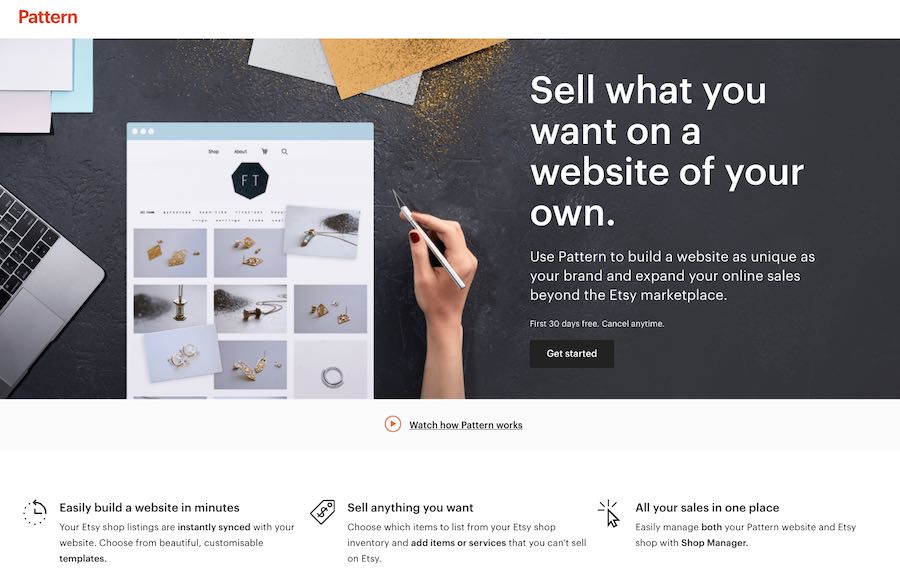
There are two ways to use Pattern. First, you can use the main version of Etsy to ‘power’ your Pattern store — this means adding a product catalogue to Etsy which populates your site with products (with inventory data being synced between the two platforms).
Alternatively, you can just add items directly to a Pattern store and sell these separately (i.e., these products won’t appear on ‘normal’ Etsy). Unlike the main Etsy platform, these don’t have to be handmade, vintage or crafting items.
Pattern costs $15 per month — $24 cheaper than the Shopify ‘Basic’ plan (the cheapest Shopify plan that lets you build a fully-customizable, standalone website). The first 30 days of your Pattern account are free (and if you cancel before this period is up, you won’t be charged).
It’s important to note, however, that Pattern by Etsy lacks many of the ecommerce features provided by Shopify (for example, abandoned cart savers, native email marketing, advanced search engine optimization features and dropshipping).
That said, it’s cheap and cheerful, integrates well with the main version of Etsy, and will suit some users.
Shipping and dropshipping
A particularly important area to look at when comparing Etsy and Shopify is shipping.
Shipping goods with Etsy
Given the emphasis on handmade and ‘one-off’ items, many Etsy merchants simply ship their own products. The platform makes this easy by allowing you to print postage labels from within the tool — you won’t need to go to the post office to buy stamps!
And Etsy offers some pretty generous discounts on postage labels too. For example, you can save up to 30% on postage when you print USPS, FedEx, and Canada Post labels using Etsy.
If you don’t want to ship your own goods, and you sell enough products to justify using a fulfilment service, the good news is that quite a lot of them work with Etsy — including Shipstation and, interestingly, Amazon’s popular FBA service.
While you’re here, check out our store builder finder tool
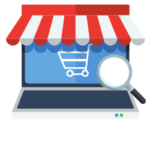
Our new store builder finder tool helps you find the right ecommerce platform for your needs. Simply answer a few questions about your requirements and get a personalized recommendation that’s right for you.
Shipping goods with Shopify
If you want to ship your own goods with Shopify, you can set your own shipping rates, rules and based on product weight, price, quantity and more — a very flexible range of options is available to you.
Depending on your country of operation, significant shipping discounts are available to you too, via ‘Shopify Shipping’ — a real-time carrier quotation system (this only works with certain carriers, but the discounts it provides are extremely generous — up to 88% in some cases).
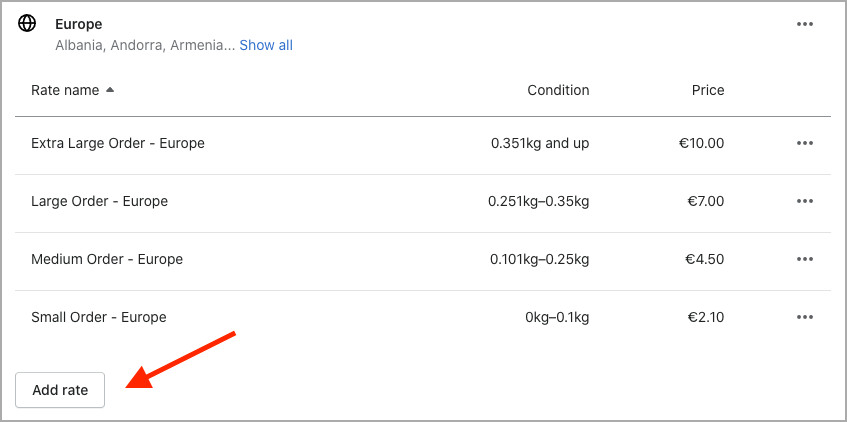
If you don’t want to fulfil your products yourself, as with Etsy you can connect your Shopify store to a third-party fulfilment service.
Alternatively, you can consider dropshipping. And speaking of that…
Dropshipping in Shopify vs Etsy
Dropshipping is a way of selling goods where you don’t make, store or fulfil any products. Rather, you take an order via your store, send it to a supplier, and they deliver the goods to your customer.
Now, Shopify is a much better solution for this type of online selling — and in many ways has been designed with it in mind.
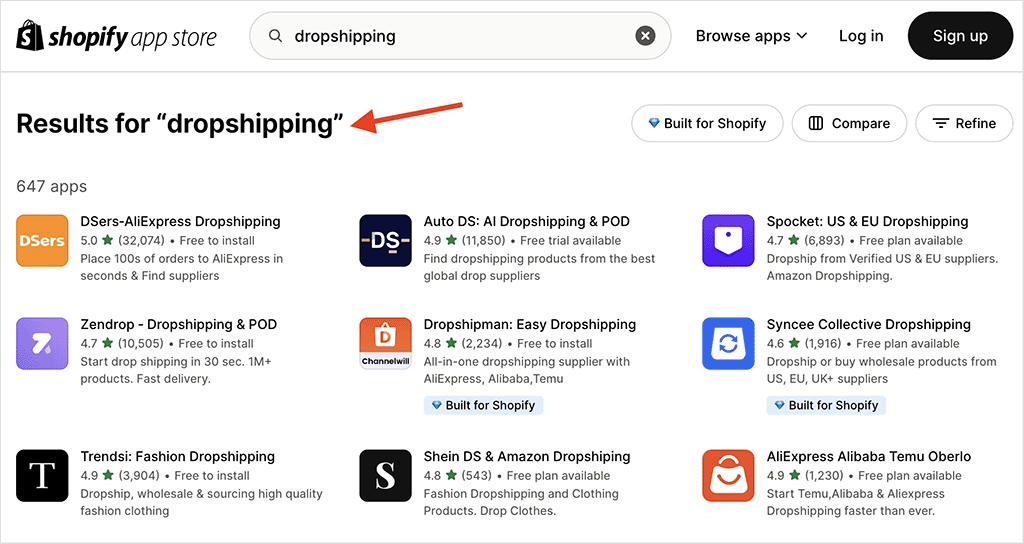
With Shopify, you can connect your online store to a very large number of dropshipping apps and source goods from a huge number of suppliers (I counted 647 in total at time of writing) — and there’s no big investment involved with doing so.
Now, given the restrictions on what you can actually sell on Etsy (handmade items, vintage goods, craft supplies and digital goods), it’s probably not a surprise that it’s not really a platform that facilitates dropshipping easily. You can get other businesses to fulfil products sold on Etsy, but only if you have designed them.
It is however possible to use Printful and Printify in conjunction with Etsy — these are print on demand services that manufacture and deliver products to your customers based on images and artwork uploaded by you.
(Our guide to connecting Etsy and Printful may be of relevance here).
💡 Tip: you can access useful resources on Shopify dropshipping here.
Attracting customers to your Shopify or Etsy store

If you’re looking for a ready-made customer base, Etsy is the winner in a Shopify vs Etsy shootout. Because of its 96 million customers and $13+bn USD in annual sales, having a storefront on Etsy technically puts you in front of a large audience that spends a lot of money.
And, if you’re selling handmade goods, vintage items or craft supplies, it’s hard to think of a ‘warmer,’ more relevant audience for you. This existing customer base is the major advantage of using Etsy over an online store builder like Shopify.
That’s not to say that you will encounter an immediate rush of customers the moment you start selling on Etsy — but your products will be quickly listed on a very popular platform.
And, so long as you’ve…
- identified a niche correctly
- created quality product descriptions
- established a strong pricing strategy
…you do stand a pretty good chance of generating sales.
By contrast, when you set up a Shopify store, you are starting entirely from scratch — so to generate a customer base, you’ll need to put a lot of effort into things like:
- SEO
- content marketing
- online advertising
- online PR.
This can be an expensive and time-consuming endeavour that involves a significant learning curve.
On the plus side, if you succeed in this, you will have a very powerful online asset that you — more or less — control fully. And Shopify has a couple of tricks up its sleeve when it comes to attracting customers that you won’t get from Etsy.
Let’s look at these.
Blogging features
The success of many ecommerce businesses is often tied to successful blogging — where interesting blog posts are used to get eyeballs onto a store.
And, thanks to its built-in blogging tool, Shopify makes it easy enough to do this sort of content marketing. Now, based on my usage of Shopify’s blogging features, it has to be said they are more basic than those of competing platforms — don’t expect the flexibility or sophistication of a WordPress blog. But that said, they do the job — you can definitely get content ranking highly using a Shopify blog.
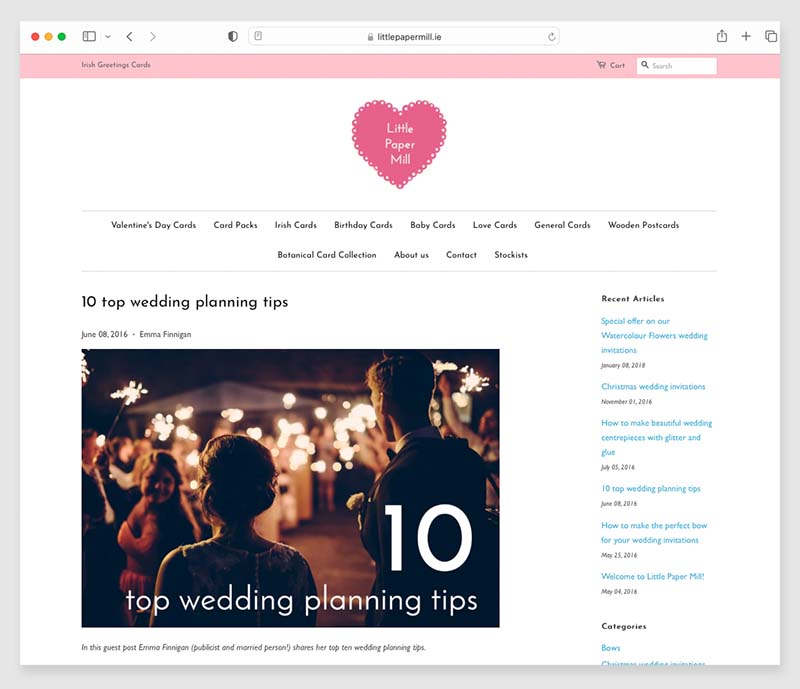
If you want to do content marketing for an Etsy product catalogue, you’ll need to set up a separate blog first (using a platform like Wix or WordPress) and insert links to your Etsy products in your posts. This can generate sales, but it involves running two distinct online presences — and is not the best way of going about things.
So it’s definitely a win for Shopify here.
Email marketing
When you subscribe to Shopify, you get access to its ‘Shopify Email’ app — a marketing tool that lets you capture email addresses, create e-newsletters and program basic autoresponder cycles. This can actually be used for free, with fairly generous send limits applying (the tool lets you send 10,000 emails per month without charge).
Etsy doesn’t offer any email marketing features — but on the plus side, you can capture and export email addresses using the platform. These can then be used in email marketing campaigns performed using third-party tools (like GetResponse or Mailchimp).
Local selling and point of sale
Selling in your local area with Etsy and Shopify
The Covid pandemic made online selling a sudden necessity for millions of ‘physical’ businesses — lockdowns meant they were forced to close their premises and embrace ecommerce overnight.
Many physical store owners turned to Shopify, and for good reason — the platform offers a very wide range of ways to sell online, facilitate product collection and offer local delivery services.
Now, because Shopify is a highly-customizable solution that lets you build your own website — rather than just list products — local businesses can use it to create fully-fledged digital presences that really reflect the essence of their physical store.
And by running a standalone site on your own custom domain name — i.e., a Shopify site that lives at yoursitename.com — you can take advantage of local SEO tactics that raise the visibility of your business in your area too.
To a degree, you can use Etsy’s Pattern product to cater to a local audience too — but in general, Etsy is more about selling niche goods to an online market.
So, if your business has a particular local focus, then due to its extensive range of SEO and customization features, Shopify is usually the better bet.
Point of sale (POS)
Thanks to its extensive point-of-sale (POS) features, Shopify can be used not just as a store builder, but as a payment processor in physical locations too.
This lets retailers use one platform to manage all their offline and online sales, and keep inventory data from both accurately synced — no matter where or how a sale has occurred.
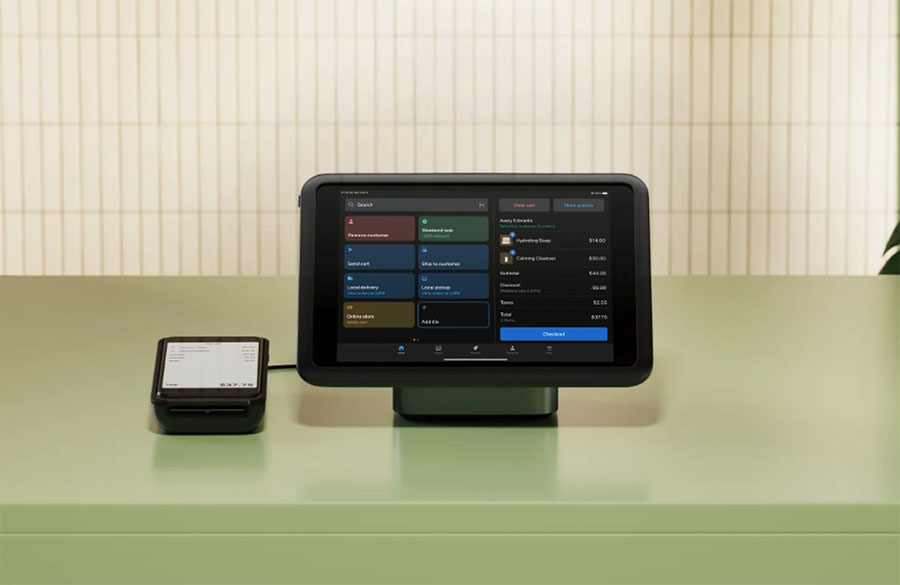
Although an integration with Square does let you use Etsy in certain point of sale contexts, this only works in certain countries (US, Canada, UK and Australia), and the sales hardware options are limited.
So Shopify is definitely the stronger product when it comes to selling in person — you can learn more about Shopify’s point-of-sale features here.
A merchant’s take on Shopify POS
I recently interviewed my friend Liz Jones — a Shopify POS merchant — to get a first-hand account of the pros and cons of using Shopify point of sale hardware and software. You can get her take on both in the video below.
SEO in Shopify vs Etsy
Whether or not you eventually choose Shopify or Etsy for your ecommerce site, making a success of it will heavily depend on your search engine optimization (SEO) efforts — and setting up a storefront on either platform means familiarising yourself with how two different search engines work.

With a standalone Shopify store, the main search engine you’ll need to focus on is Google — it’s the search engine that most of your potential customers will be using to search for products like yours. (Google currently handles around 90% of all search engine queries).
Unsurprisingly this means that Shopify gives you a flexible range of SEO tools that you won’t really find in Etsy. In Shopify, you get full control over all key SEO components (titles, headings, meta descriptions, alt text, robots.txt, redirects etc.) plus access to a lot of SEO apps too (including, significantly, Yoast).
Etsy does give you access to some SEO settings, but only the basics are catered for really (i.e., item titles, descriptions and image alt text).
This is probably because when you sell on Etsy, you’re primarily focussing on a different search engine — Etsy’s own one. This works in a different way to Google’s — it aims to present search results to people who are ready to buy, rather than people who might buy.
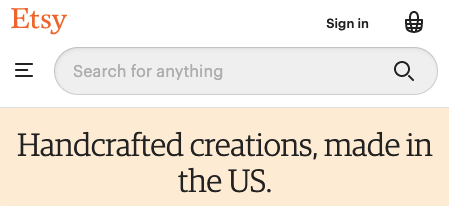
Ultimately, to get the most out of your Shopify or Etsy store, you will need to conduct quality research into the best SEO techniques for both. I’d recommend checking out our Shopify SEO guide as a starting point for optimizing a Shopify store for search engines, and Printful’s guide to Etsy SEO for Etsy.
Perhaps the main SEO advantage of an Etsy store is that unlike a Shopify one, it presents you with two SEO opportunities. Not only can you optimize your product catalogue for Etsy’s search engine but, since your Etsy catalogue can be crawled by other search engines too, you can get them indexed by Google as well.
This means that technically, an Etsy shop provides you with more opportunities to get your products in front of a search audience than a Shopify one.
Customer support for Shopify and Etsy
Shopify offers customer support by live chat, while Etsy goes further by providing email and phone support too. Additionally, a variety of searchable online resources and community forums are available to help you learn more about both products.
As is typical with a lot of ecommerce platforms these days, when you look for contact details, you are prompted by both Shopify and Etsy to search the help pages for an answer first.
Only after doing so will you get access to contact details for the support team (something that I always find rather annoying).
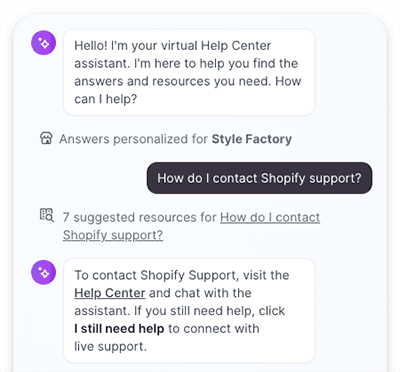
In terms of the number of languages you can receive support in, Shopify provides it in 18 languages; Etsy offers it in 11.
While you’re here, download our free ecommerce e-kit
For a limited time, we’re offering our readers some excellent free tools. Sign up free to immediately receive:
- our online store comparison chart
- a downloadable cheatsheet on how to create an online store
- our SEO, blogging and ‘how to start a business’ cheatsheets
- extended free trials and discount codes for essential business apps
- our latest tips on ecommerce and growing a business
Shopify and Etsy pricing
We’ve discussed how Shopify and Etsy work, and their respective key features — now it’s time to look at how much they actually cost to use.
Shopify fees
There are five Shopify pricing plans to consider:
- Shopify Starter — $5 per month
- Basic Shopify — $39 per month
- Grow — $105 per month
- Advanced Shopify — $399 per month
- Shopify Plus — custom pricing, but starting at $2,300 per month.
A free Shopify trial is also available — you can access this via this link.
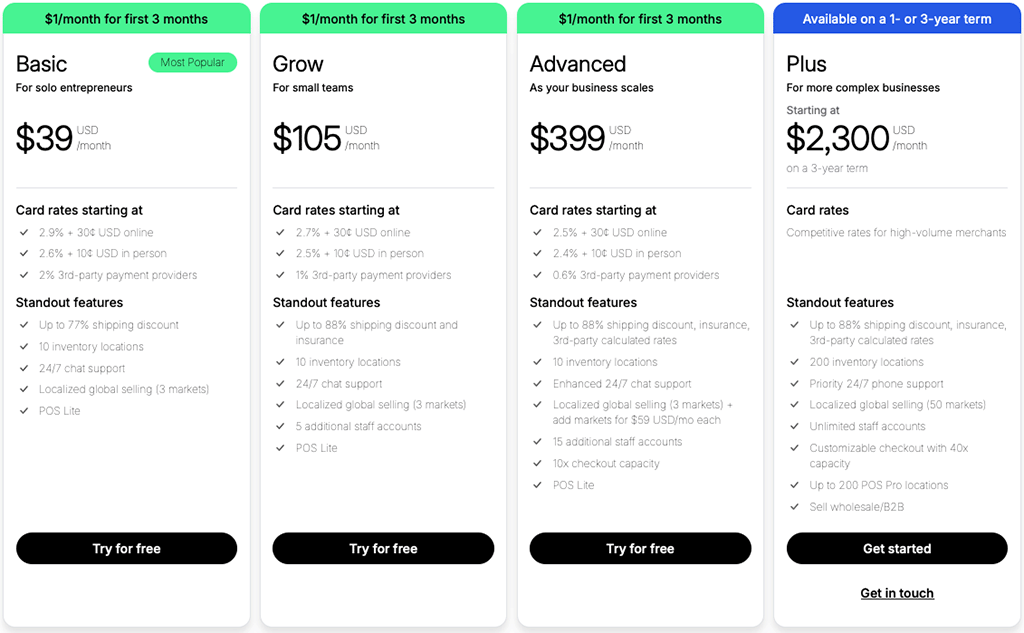
All the Shopify plans give you access to core ecommerce functionality (including unlimited physical and digital product catalogues, credit cart processing, gift cards, abandoned cart recovery, discount codes and an SSL certificate).
That said, there are some important differences to watch out for between Shopify plans. These are as follows:
- The Shopify ‘Starter’ plan doesn’t let you build a fully-customizable standalone online store. Rather, it supplies you with a very basic online storefront, enables you to sell on social media and messaging apps (Instagram, Facebook, WhatsApp etc.) and add a product catalog to an existing website via an embeddable ‘buy button.’
- How many users you can have on your account varies a lot by plan. The ‘Starter’ and ‘Basic’ Shopify plans only give you 1 staff account, the ‘Grow’ plan gives you 5 and the ‘Advanced’ plan lets you have fifteen.
- Detailed ecommerce reports are only available on the $105 ‘Grow’ plan or higher.
- Credit card fees range from 2.5% to 2.9% in the US depending on the plan you’re on. (In other countries, these fees are often lower).
- Transaction fees are not applied if you use Shopify Payments (Shopify’s built in payment gateway). If you use a third-party payment processor, transaction fees do apply and these vary depending on the plan you’re on (from 0.6% up to 2%).
- The ‘Shopify Plus‘ plan is focused on enterprise users, and prices vary depending on needs. On this plan, you can expect advanced security, access to more apps, API and fulfilment features and ‘white glove’ style account management (you can learn more about the differences between Shopify and Shopify Plus here).
Etsy fees
There are two main fee types to consider in Etsy:
- Listing fees — $0.20 per item
- Transaction fees — 6.5% per item sold
Etsy listings expire after 4 months, but you can set a listing to auto-renew. An auto-renew fee of $0.20 applies, meaning that it costs $0.60 to list a product on your store for a year.

You can also subscribe to a service called ‘Etsy Plus,’ which involves a monthly fee of $10. For this you get 15 listing credits and $5 credits for Etsy Ads per month (Etsy Ads let you advertise your products in Etsy search results and other pages).
Etsy Plus brings a couple of other benefits: a 30% discount from the printer MOO, and depending on your country of operation, discounts on shipping boxes too.
And, as discussed earlier, you can pay $15 per month to create a ‘Pattern’ store with Etsy — a basic standalone, ecommerce site.
From a pricing perspective, the main advantage of using Etsy over Shopify is that — so long as you’re using the ‘listings’ version of the platform — it lets you avoid monthly fees. The main disadvantage is that its transaction fees are very high compared to Shopify’s.
Etsy Payments
When you sell on Etsy, you are required to do so via ‘Etsy Payments’ — Etsy’s in-house payment processing system.
This lets you accept a wide range of credit cards and other popular payment methods including Apple Pay, Google Pay and PayPal, and it works in around 53 countries.
It’s important to note however that when you use Etsy Payments,
- credit card fees will apply in addition to Etsy’s standard 6.5% transaction fee (in the US and the UK, these fees are 3% + 25c and 4% + 20p respectively).
- a ‘scheduled deposit’ system is employed, so money can take time to reach your account.
Using Shopify and Etsy together
Although so far in this comparison I’ve highlighted the many differences between Shopify and Etsy, it’s important to understand that you don’t have to use them in a mutually exclusive way.
The Shopify app store is well-stocked with integrations and third party apps that let you connect a Shopify store to Etsy and list, manage and sync your products across both platforms (see screenshot below for a few examples of these).
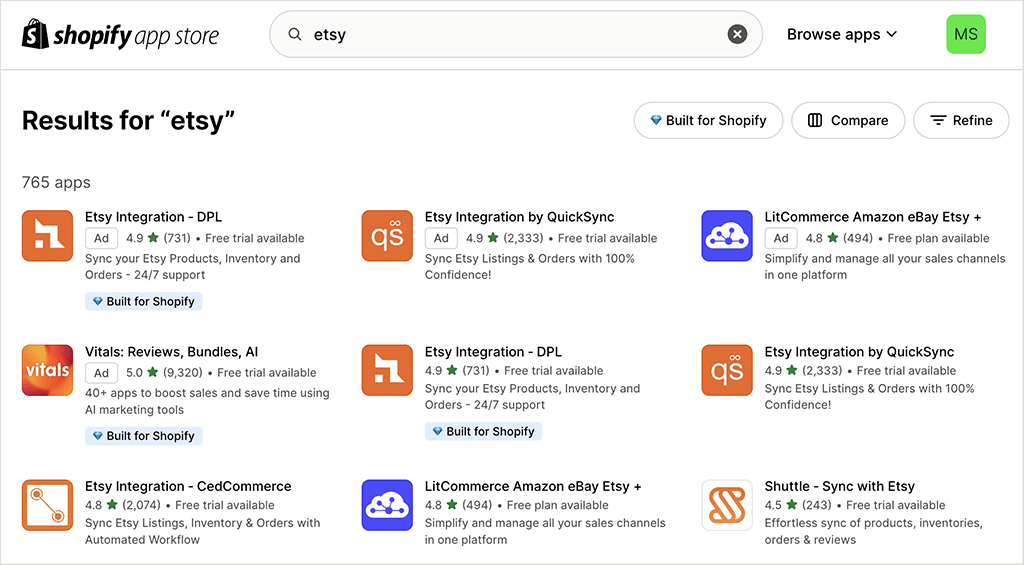
Additonal fees will usually apply to install these apps and integrations, but the point is that you can use them to get the best of both worlds — a brand and website of your own via Shopify, and access to a large online marketplace via Etsy.
By having a presence on both platforms, you’re giving yourself the most ways to grow your online business.
Shopify vs Etsy: conclusion and pros and cons summary
When I compare two different ecommerce platforms, my aim is usually to declare a ‘winner.’ However, because Shopify and Etsy are quite different tools, in this case it’s more useful for me to highlight the contexts where it makes more sense for you to use one over the other.
So, below you’ll find a summary of my main reasons for using Shopify or Etsy. And do leave a comment if you have any questions!
Reasons I’d use Shopify instead of Etsy
- Shopify is a better option for sellers who need a standalone site on their own domain.
- It is considerably more customizable, and lets you create a much more ‘on-brand’ presence than Etsy.
- It’s a considerably better platform for starting a dropshipping business with.
- The sophisticated Shopify POS system makes the platform a better option for small businesses in need of local selling and point-of-sale tools.
- It gives you a built in-blog.
- It gives you access to a very usable (and free) email marketing app.
- It lets you list products on Etsy, giving you the best of both worlds.
- Support for Shopify is available in more languages.
- Shopify’s payment processing fees are lower — you’ll typically pay 2.5% to 2.9% per sale, which compares very positively with Etsy’s 6.5%
👉 Free trial: Get an extendable Shopify trial here
Reasons I’d use Etsy instead of Shopify
- It puts your products in front of a large existing audience: the Etsy marketplace contains millions of people that you can theoretically start selling to immediately. With Shopify you will have to work harder to develop a customer base.
- You can avoid monthly fees entirely with Etsy — but with Shopify, you’re usually looking at a minimum monthly charge of $39 per month.
- Because with Etsy you are simply listing your products on an existing online store, you don’t have to worry about any web design work. Using Shopify means registering a domain and building a brand new ecommerce website.
- Etsy’s existing audience is one that is particularly receptive to handmade, vintage and craft goods — if you work in those niches, it’s a highly relevant, creative marketplace for you to sell on.
- Etsy sellers can target two ‘search audiences’ — people using Etsy’s own popular search engine, and those using other search engines like Google or Bing. With Shopify you essentially have access to one search audience (i.e., users of traditional search engines).
Shopify and Etsy alternatives
When it comes to alternatives to Shopify, there’s no shortage of ecommerce platforms available that claim to offer similar selling functionality.
Of these, I usually recommend BigCommerce as the most obvious alternative to Shopify; it’s similarly priced and offers a broadly comparable feature set. Check out our BigCommerce vs Shopify comparison here, our BigCommerce YouTube review here or read our full BigCommerce review here.
Squarespace is also worth investigating — while its ecommerce features are not quite as comprehensive as Shopify’s, it’s very easy to use and comes with some outstanding templates. You can check out our Shopify vs Squarespace comparison here (our guide to the Squarespace free trial and our Squarespace pricing plans overview might also be of interest).
Users on a very low budget might also want to consider Big Cartel. While not as fully-featured as Shopify, it does nonetheless let you build a standalone online storefront, and quite cheaply too.
Wix is another reasonably low-cost option — you can watch our Wix vs Shopify video below to get a sense of the main differences between it and Shopify.
As for Etsy, its online marketplace is fairly unique, and new businesses will be hard pressed to find a similar space where they can reach quite so many customers with an interest in creatively-produced goods.
That said, there are quite a few other online marketplaces that might still work well for your niche — Amazon and eBay are two obvious ones. (Our Shopify vs Amazon shootout and Shopify vs eBay comparison will be of relevance here).
You might also like to take a look at EarthHero, an ethical online marketplace that often appeals to users of sites like Etsy.
Shopify vs Etsy FAQ
Can you use Shopify and Etsy for free?
You can avail of a 3-day free trial for Shopify, after which your first month will cost just $1 if you subscribe to a Shopify plan. With Etsy, you can create a store for free but you will be charged a 20 cent listing fee for each product and a transaction fee on each sale.
Can you use Shopify and Etsy together?
You can use Shopify and Etsy together via integrations available from Shopify’s app store. Depending on the chosen integration, charges may apply however.
What’s the main reason for using Shopify over Etsy?
The main reason for using Shopify over Etsy is that it gives you 100% control over every aspect of your store — what you sell, how you present it and where you sell it. Etsy restricts you to selling certain types of goods (handmade products, craft supplies or vintage items); it doesn’t let you edit your storefront extensively; and its point-of-sale features are limited. Shopify gives you 100% flexibility in all these areas.
What’s the main reason for using Etsy over Shopify?
The main reason for using Etsy over Shopify is that it gives you access to a ready-made (and large) audience. With Shopify, you will have to invest time and money in SEO, online marketing and other promotional efforts to build a customer base. By contrast in Etsy, it’s already there — millions of people regularly search the marketplace for products and if your Etsy listings are well-crafted enough, you may be able to avail of relevant traffic (and by extension sales) more quickly.
Comments (2)
I am a complete novice and felt compelled to leave a review. What a thorough, easy to follow breakdown of the pros and cons of these two ecommerce platforms. Thank you for sharing your experience. Jx
Thanks for the kind words Jane! Glad you found the comparison helpful.